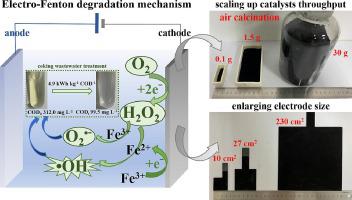Chemical Engineering Journal ( IF 13.3 ) Pub Date : 2023-06-13 , DOI: 10.1016/j.cej.2023.144104
Kaixuan Wang , Peike Cao , Xin Qin , Shuo Chen , Hongtao Yu , Xie Quan

|
Electro-Fenton (EF) regarded as a green substitution to traditional homogeneous Fenton, produces highly oxidizing  OH through in-situ H2O2 electrosynthesis and electrochemical Fe2+ regeneration. One of obstacles that hinders translation of bench-scale EF performance to water treatment practices is the difficulty of scaling up catalyst/electrode preparation in low cost while producing high performance. Here we report scalable preparation of modified carbon catalysts for high-efficiency EF by directly calcinating commercial carbonaceous materials in air. The EF with modified carbon cathode shows high kinetics of 0.296–0.569 min−1 for levofloxacin removal in much wider pH range of 3.0–6.6 using less Fe dosage compared with homogeneous Fenton. This EF system can reduce chemical oxygen demand (COD) of coking wastewater from 312.0 to 99.5 mg L−1 to satisfy wastewater discharge standard in China while consuming low electricity of 1.8–4.9 kWh kg−1 COD−1. We demonstrated the scalability of this EF process by scaling up preparative throughput of catalyst (30 g that can be processed into electrodes with total working areas of 54000 cm2), enlarging electrode size (230 cm−2) and reactor volume with wastewater treatment capacity of 7.2 L/h. This scalability demonstration of EF technology shows the promising potential of achieving low-cost advanced wastewater treatment.
OH through in-situ H2O2 electrosynthesis and electrochemical Fe2+ regeneration. One of obstacles that hinders translation of bench-scale EF performance to water treatment practices is the difficulty of scaling up catalyst/electrode preparation in low cost while producing high performance. Here we report scalable preparation of modified carbon catalysts for high-efficiency EF by directly calcinating commercial carbonaceous materials in air. The EF with modified carbon cathode shows high kinetics of 0.296–0.569 min−1 for levofloxacin removal in much wider pH range of 3.0–6.6 using less Fe dosage compared with homogeneous Fenton. This EF system can reduce chemical oxygen demand (COD) of coking wastewater from 312.0 to 99.5 mg L−1 to satisfy wastewater discharge standard in China while consuming low electricity of 1.8–4.9 kWh kg−1 COD−1. We demonstrated the scalability of this EF process by scaling up preparative throughput of catalyst (30 g that can be processed into electrodes with total working areas of 54000 cm2), enlarging electrode size (230 cm−2) and reactor volume with wastewater treatment capacity of 7.2 L/h. This scalability demonstration of EF technology shows the promising potential of achieving low-cost advanced wastewater treatment.































 京公网安备 11010802027423号
京公网安备 11010802027423号